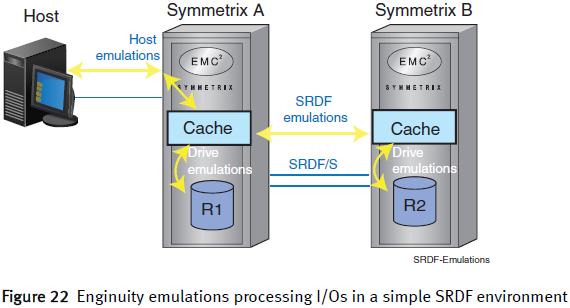Sessions & Emulations
Symmetrix session
Enginuity uses the Symmetrix session mechanism to deliver Enginuity features without interrupting production applications. SRDF/A and SRDF/Star all use the session mechanism.
Symmetrix sessions have the following common characteristics:
- Users configure, initiate, poll, and terminate Symmetrix sessions via Symmetrix host-based control software that typically runs on a dedicated controlling host.
- Enginuity provides all session-specific functionality without requiring any resources from the application hosts.
- Enginuity limits the number of concurrent sessions per Symmetrix device to 16. Symmetrix host-based control software may impose additional restrictions.
Enginuity emulations and I/O operations
In Symmetrix arrays, the Enginuity operating system provides executables (also known asEnginuity emulations) that manage I/O execution, data protection, integrity, and data availability. Every processor in every Symmetrix director is loaded with specific Enginuity emulation code. Enginuity coordinates independent processors to act as one integrated cached disk array.
In SRDF configurations, Enginuity sends host updates across the SRDF links, for example, from R1 to R2 devices. SRDF I/O flow depends on the SRDF mode of operation.
- Host emulations - Manage I/Os between the host and the Symmetrix array, moving data between the host interface cards and cache in the primary array.
- SRDF emulations - Manage data movement across the SRDF links between cache in the primary and cache in the secondary array.
- Drive emulations - Manage data movement between cache and drives within a single Symmetrix array.

Enginuity emulations operate the same way in both simple SRDF configurations and in complex, multi-site SRDF configurations. Enginuity emulations use a messaging or a queue mechanism to communicate and coordinate their activities.
